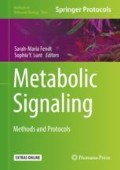Abstract
Tumorigenesis relies on the ability of cancer cells to obtain necessary nutrients and fulfill increased energy demands associated with rapid proliferation. However, as a result of increased metabolite consumption and poor vascularization, most cancer cells must survive in a nutrient poor and high cellular stress microenvironment. Cancer cells undergo metabolic reprogramming to evade cell death and ensure proliferation; in particular, cancer cells utilize the catabolic process of autophagy. Autophagy creates an intracellular pool of metabolites by sequestering cytosolic macromolecules in double-membrane vesicles targeted for lysosomal degradation. During times of environmental stress and nutrient starvation, autophagy is upregulated through the dynamic interactions between two nutrient sensing proteins, AMP activated protein kinase (AMPK) and mechanistic target of rapamycin (mTOR), in cooperation with Unc-51 like autophagy activating kinase 1 (ULK1). In this way, a lack of metabolic nutrients plays a critical role in inducing autophagy, while the products of autophagy also serve as readily available fuel for the cell. In this chapter, we describe methods to visualize and quantify autophagy using a fluorescent sensor of autophagic membranes. Thus, the impact of specific nutrients on autophagy can be measured using live-cell fluorescent microscopy.
Access this chapter
Tax calculation will be finalised at checkout
Purchases are for personal use only
References
Pavlova NN, Thompson CB (2016) The emerging hallmarks of cancer metabolism. Cell Metab 23(1):27–47. https://doi.org/10.1016/j.cmet.2015.12.006
Warburg O (1924) On the metabolism of cancer cells. Naturwissenschaften 12:1131–1137. https://doi.org/10.1007/Bf01504608
Warburg O, Posener K, Negelein E (1924) On the metabolism of carcinoma cells. Biochem Z 152:309–344
Warburg O, Wind F, Negelein E (1927) The metabolism of tumors in the body. J Gen Physiol 8(6):519–530
Lukey MJ, Katt WP, Cerione RA (2017) Targeting amino acid metabolism for cancer therapy. Drug Discov Today 22(5):796–804. https://doi.org/10.1016/j.drudis.2016.12.003
Klionsky DJ (2007) Autophagy: from phenomenology to molecular understanding in less than a decade. Nat Rev Mol Cell Biol 8(11):931–937. https://doi.org/10.1038/nrm2245
Codogno P, Meijer AJ (2005) Autophagy and signaling: their role in cell survival and cell death. Cell Death Differ 12(Suppl 2):1509–1518. https://doi.org/10.1038/sj.cdd.4401751
Saxton RA, Sabatini DM (2017) mTOR signaling in growth, metabolism, and disease. Cell 169(2):361–371. https://doi.org/10.1016/j.cell.2017.03.035
Mack HI, Zheng B, Asara JM et al (2012) AMPK-dependent phosphorylation of ULK1 regulates ATG9 localization. Autophagy 8(8):1197–1214. https://doi.org/10.4161/auto.20586
Martin KR, Barua D, Kauffman AL et al (2013) Computational model for autophagic vesicle dynamics in single cells. Autophagy 9(1):74–92. https://doi.org/10.4161/auto.22532
Merrill NM, Schipper JL, Karnes JB et al (2017) PI3K-C2alpha knockdown decreases autophagy and maturation of endocytic vesicles. PLoS One 12(9):e0184909. https://doi.org/10.1371/journal.pone.0184909
Acknowledgment
This work was supported by NIH grant number R01CA197398 from the National Cancer Institute. The funders had no role in study design, data collection and interpretation, or the decision to submit the work for publication.
Author information
Authors and Affiliations
Corresponding author
Editor information
Editors and Affiliations
Rights and permissions
Copyright information
© 2019 Springer Science+Business Media, LLC, part of Springer Nature
About this protocol
Cite this protocol
Guillaume, J.D., Celano, S.L., Martin, K.R., MacKeigan, J.P. (2019). Determining the Impact of Metabolic Nutrients on Autophagy. In: Fendt, SM., Lunt, S. (eds) Metabolic Signaling. Methods in Molecular Biology, vol 1862. Humana Press, New York, NY. https://doi.org/10.1007/978-1-4939-8769-6_11
Download citation
DOI: https://doi.org/10.1007/978-1-4939-8769-6_11
Published:
Publisher Name: Humana Press, New York, NY
Print ISBN: 978-1-4939-8768-9
Online ISBN: 978-1-4939-8769-6
eBook Packages: Springer Protocols

